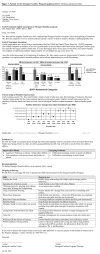Outcome progress letter types: parent and physician preferences for letters from pediatric mental health services
- PMID: 22170209
- PMCID: PMC3237535
Outcome progress letter types: parent and physician preferences for letters from pediatric mental health services
Abstract
Objective: To determine health care professional and parental preferences for receiving progress letters from a pediatric mental health program between a traditional text-only format and a version in which information was presented using graphs and tables with limited text.
Design: Mailed survey.
Setting: Nova Scotia.
Participants: Parents (n = 98) of children who received treatment from and health care professionals (n = 74) who referred patients to the Strongest Families Program (formerly the Family Help Program) were eligible. Most of the health care professionals were family practitioners (83.8%).
Main outcome measures: Preference between 2 letters that contained the same content (including progress in the program, results from a questionnaire, and resolved and ongoing problems) in different formats--one using text only, the other using graphs as well as text.
Results: In total, 83.8% of health professionals and 76.5% of parents indicated that they preferred to receive feedback in letters containing information in graphical format. Background and demographic information did not predict preferences. Parents preferred to receive progress letters at the beginning, midway through, and at the end of treatment, and health professionals preferred to receive progress letters at the beginning and end of treatment.
Conclusion: When receiving progress letters from a pediatric mental health program, health care professionals and parents preferred to receive letters that used graphs to help convey information.
Objectif: Déterminer si les professionnels de la santé et les parents préfèrent recevoir des lettres de suivi d’un programme de santé mentale pédiatrique sous forme de texte traditionnel uniquement ou sous un format combinant un texte plus court ainsi que des graphiques et tableaux.
Type d’étude: Enquête postale.
Contexte: Nouvelle-Écosse.
Participants: Étaient éligibles les parents (N = 98) et les enfants qui avaient été traités par le Strongest Families Program (autrefois appelé Family Help Program), et les professionnels de la santé (N = 74) qui avaient dirigé des patients vers ce programme. La plupart de ces derniers étaient des médecins de famille.
Principaux paramètres à l’étude: Type de format préféré entre 2 lettres ayant le même contenu (c.-à-d. les progrès réalisés au sein du programme, les résultats d’un questionnaire, et les problèmes résolus et/ou encore présents), une lettre sous forme de texte seulement et l’autre utilisant des graphiques avec un texte.
Résultats: Dans l’ensemble, 83,8 % des professionnels de la santé et 76,5 % des parents ont indiqué préférer recevoir les lettres de suivi accompagnées de graphiques. Les renseignements sur les antécédents et les données démographiques n’avaient pas d’influence sur les préférences. Les parents préféraient recevoir des lettres de suivi au début, au milieu et à la fin du traitement, tandis que les professionnels de la santé préféraient les recevoir au milieu et à la fin du traitement.
Conclusion: Lorsqu’ils reçoivent des lettres de suivi d’un programme de santé mentale pédiatrique, les parents et les professionnels de la santé préfèrent que ce soit sous un format accompagné de graphiques pour mieux communiquer l’information.
Figures
Similar articles
-
A process for developing community consensus regarding the diagnosis and management of attention-deficit/hyperactivity disorder.Pediatrics. 2005 Jan;115(1):e97-104. doi: 10.1542/peds.2004-0953. Pediatrics. 2005. PMID: 15629972
-
Copying letters to children and parents: audit and survey of nurses' views.Paediatr Nurs. 2008 Oct;20(8):28-33. doi: 10.7748/paed2008.10.20.8.28.c8265. Paediatr Nurs. 2008. PMID: 18980038
-
Letter writing to parents following paediatric outpatient consultation: a survey of parent and GP views.Child Care Health Dev. 1996 Sep;22(5):303-10. Child Care Health Dev. 1996. PMID: 8879755
-
Where have all the copy letters gone? A review of current practice in professional-patient correspondence.Patient Educ Couns. 2008 May;71(2):259-64. doi: 10.1016/j.pec.2007.12.002. Epub 2008 Jan 25. Patient Educ Couns. 2008. PMID: 18222056 Review.
-
Valued Components of a Consultant Letter from Referring Physicians' Perspective: a Systematic Literature Synthesis.J Gen Intern Med. 2018 Jun;33(6):948-954. doi: 10.1007/s11606-018-4356-3. Epub 2018 Mar 5. J Gen Intern Med. 2018. PMID: 29508258 Free PMC article.
Cited by
-
Imagine a mental health service that builds stronger families.Paediatr Child Health. 2016 Jun-Jul;21(5):247-8. doi: 10.1093/pch/21.5.247. Paediatr Child Health. 2016. PMID: 27441017 Free PMC article. No abstract available.
References
-
- McGrath PJ, Lingley-Pottie P, Thurston C, MacLean C, Cunningham C, Waschbusch DA, et al. Telephone-based mental health interventions for child disruptive behavior or anxiety disorders: randomized trials and overall analysis. J Am Acad Child Adolesc Psychiatry. 2011;50(11):1162–72. Epub 2011 Sep 3. - PubMed
-
- Lingley-Pottie P, McGrath PJ. A therapeutic alliance can exist without face-to-face contact. J Telemed Telecare. 2006;12(8):396–9. - PubMed
-
- Lingley-Pottie P, McGrath PJ. Telehealth: a child-friendly approach to mental health care reform. J Telemed Telecare. 2008;14(5):225–6. - PubMed
-
- Lingley-Pottie P, McGrath PJ. A paediatric therapeutic alliance occurs with distance intervention. J Telemed Telecare. 2008;14(5):236–40. - PubMed
-
- Lingley-Pottie P, McGrath PJ. Distance therapeutic alliance: the participant’s experience. ANS Adv Nurs Sci. 2007;30(4):353–66. - PubMed
Publication types
MeSH terms
Grants and funding
LinkOut - more resources
Full Text Sources
Medical

